Note – This piece was previously published in Percussive Notes, Vol. 32, No 4 August 1994, page 54-64.
Reprinted by permission of the Percussive Arts Society, Inc., 701 N.W., Ferris, Lawton, OK 73507
Introduction

The tabla is a pair of drums which has become synonymous with north Indian percussion (figure 1. below). Although the tabla is probably not more than two to three centuries old, it has assumed an important role in this ancient system of music. For many generations material has been transmitted orally from teacher to disciple. In this way numerous compositions and compositional forms have arisen.
This myriad of styles and compositional forms essentially break down into two philosophies; cyclic and cadential (Stewart 1974). The cyclic form rolls along and does not imply or require a resolution. This class includes such common examples as theka, rela, or kaida. In contrast, the cadential form requires a resolution. It is the cadential material which is the topic for this work.
There are numerous traditional types which may be considered a cadence. Unfortunately the nomenclature is often conflicting and overlapping. It will be seen in this paper that such confusion often arises because different criteria is used for the definition. When one understands the criteria upon which a compositional form is defined, the confusion is minimized.
| IF YOU ARE INTERESTED IN TABLA, THIS BOOK IS FOR YOU |
|---|
This is the first volume of the most complete series on the tabla. Fundamentals of Tabla It is available around the world. Check your local Amazon for pricing. |
Background
It is necessary to have a firm background in the basics of Indian rhythm before we discuss the cadence. Although a complete discussion of Indian theory and notation is not possible here, we will cover the fundamentals. These are the system of mnemonics; abstract concepts of time and rhythm; and concepts of structure.
The system of mnemonics, known as bol, is perhaps the most distinctive characteristic of Indian percussion. Bols such as Dha, Dhin TiRiKiTa are used both as a basis for notation as well as a mnemonic (Courtney 1980). The word bol is so attached to the strokes that it has come to mean both the verbal recitation as well as the performance of the strokes.
An analysis of these bols show two overall styles. One of these styles shows the influence of an ancient barrel shaped drum known as pakhawaj. Another style has obscure origins, variously attributed to naggada (Stewart 1974), dholak, dholki or any of a variety of folk sources. Efforts to attribute this style to any particular drum are inconclusive. The usual approach used by Indian musicians is to simply refer to them as “tabla bols“. Although this approach may be unsatisfactory from an academic standpoint we will use this convenient convention in this work.
The various bols are important for Indian percussion, however they must be placed within the context of rhythmic theory. India has a highly developed time theory based upon beats (matra), measures (vibhag) and cycles (avartan)(Courtney 1993).
The matra is the fundamental unit of rhythm. Matra is directly translatable to the word beat. It does not specify any absolute time value but instead may have a broad spectrum of values. This is because there are a wide range of tempi in Indian music and the time value for the matra changes accordingly. Although matra is the smallest theoretical unit it should be noted that it may be subdivided according to one’s convenience.
The next higher structural unit is the vibhag. Vibhag is analogous to the Western concept of measure or bar. Unlike the Western measure, the Indian vibhag implies certain concepts of clapping. A vibhag may be described as tali which means “to be clapped”, or khali which is denoted by a wave of the hand. It is this system of clapping and waving which lies at the core of Indian timekeeping. Indeed the Sanskrit word tal means both abstract rhythm as well as the clapping of hands (Apte 1933).
The avartan is the highest structural component and is the most important concept for our discussion of the cadenza. The avartan is the cycle of Indian music. Common cycles are composed of 6, 7, 8, 10, 12, 14, and 16 beats.
Figure 2. Tintal Theka
Figure 2 illustrates these various points. The more usual notation is shown in a Sanskrit (Devnagri) while Western elements have been added for the benefit of the non-Indian reader. The example shows a common tal known as tintal. We see that it is composed of four vibhag, of four matras each, for a total of 16 matras. The individual strokes are specified with the bol (i.e., Dha, Dhin, etc.). One should notice that the beginning of each measure is designated by a symbol (i.e., cross, number or zero). These indicate the clapping arrangement (tali). The waves of the hand (khali) are designated with a “0” while the claps are designated with a number. The number designates a first clap, second clap, third clap, etc. One cannot help but notice that the first clap was not designated with “1” but a cross. The use of a cross for the first vibhag is very significant. The first beat of the cycle is referred to as sam. In Sanskrit the word sam means “with”, “together”, or “common” (Apte 1933).
There is an interesting relationship between this basic timekeeping and the performance. One may find alternation between blinding bursts of speed and slow simple accompaniment. Yet through all of these alternations, the basic rhythm usually does not change. Therefore, this sets up a situation where we have two rhythms going on simultaneously. One rhythm is the abstract basic tal indicated by the claps and waves. The other one is the actual performed piece. The relationship between the performed and the abstract is referred to as layakari. Common layakari are single-time, double-time, triple-time, etc. One also finds interesting layakari such as three-beats-over-two, seven-beats-over-four, etc.
Indian percussion is more than notational and rhythmic theory; there is also an extensive theory of composition. Although tabla is famous for its improvisation one must not think of improvisation in Western terms. It is never totally free-form but rather an extemporaneous composition within well defined rules and compositional forms. These have names like kaida, rela, peshkar, tihai and a host of others which are unfamiliar to the average Western musician.
Although there are many compositional forms there are really only two overall classes; cyclic and cadential. These mutually exclusive classes are based upon simple philosophies. The cyclic class is that which rolls along without any strong sense of direction. These include our basic accompanying patterns (theka and prakar); formalized theme and variation (kaida); and a host of others which are not within the scope of this article. One may generally ascribe a feeling of balance to this class. In contrast, the cadential class has a feeling of imbalance. It moves forward to an inevitable point of resolution, usually on the sam. Common cadenzas are the tihai, mukhada, paran and a host of others which will be discussed in this paper.
The terms tihai, paran, mukhada, etc. create many difficulties for the student of Indian music. One inevitably encounters contradictions, overlapping definitions, and vagaries which are disturbing to a Westerner who desires the theoretical system to be neat and clean. It is the purpose of this article to show that the system of nomenclature is not quite as vague as it appears. The contradiction in terms occasionally result from differing musical subtraditions. In the old days there arose different dialects of tabla. Geographical isolation created differences in style and nomenclature. Today these differences are being slowly worked out, largely due to the efforts of educators to create an organized syllabus for the music colleges (Courtney 1992). Although it is largely resolved at the academic level, individual musicians often do not have an academic background. Therefore one tends to find more confusion at the level of the rank and file musician.
We may now summarize the important aspects of the Indian rhythmic system. Pivotal to this system is the use of mnemonics known as bol. The various bols are assembled into larger material which falls into certain forms. Philosophically, this material may be cyclic or cadential. All compositions must adhere to the basic rules of time theory. Such time theory is based upon cycles, measures and beats. Within this framework, the first beat of the cycle has a special significance for it is the point of resolution. This background is essential for the forthcoming discussion of the criteria used to define the compositional forms.
Criteria
There are a number of criteria used to define the cadential forms. These are the function, structure, and the bol of the composition.
The experience of Western ethnomusicologists in their studies of compositional forms is somewhat analogous to that of a spaceman suddenly trying to make sense of the various classifications of human beings. Moving within human culture, a particular individual may be classed as male, Democrat, Presbyterian, Freemason, or any of a number of labels to which we assign an individual. The overlapping nature of these classes may be very confusing to our spaceman until he realizes that these labels are based upon totally different criteria.
A similar situation exists with Indian percussion. Function, structure and bol are three independent criteria used to define our compositional forms. One typically finds one or two criteria used for a definition, but rarely one will find all three. Therefore, it is common to find the same composition called different things on different occasions by different musicians.
Function – Function is the criterion that concerns how and when a musician uses a composition. One composition may be used to start or end a section; one may be reserved for encores, or tabla solos. There are some pieces which are reserved for specific styles such as light, filmi, classical, folk or dance music. Function may be thought of as a gestalt of artistic, traditional and stylistic factors. Two forms may be said to be functionally identical if they may be interchanged. For instance, although tukada, and paran are totally separate cadential forms, one may substitute a one-cycle paran for a one-cycle tukada without any break in the flow of a piece. Therefore, at the level of function the two are identical, though they may be differentiated at another level.
Structure – Structure is the criterion based upon the anatomy of the composition. One piece may be based upon a phrase repeated three, four or nine times. One piece may be evenly split in two. One may exhibit a symmetry while another may be asymmetric. Some may cover several cycles while others may be restricted to but a few beats. These are the structural considerations of apiece.
Bol – The bol is the final criterion for defining a compositional type. Some compositions may be based upon resonant strokes such as Dha, Ge, Tun, etc.; while some may be restricted to flat, nonresonant bols. Some may be based upon bols which are derived from an ancient barrel shaped drum known as pakhawaj; while somemay be based upon purely tabla bols. Some may be based upon dance bols and some may even be based upon Hindi or Sanskrit poetry. These are the types of bols which are used to define some composition.
Although the differing criteria is critical for the proper definition of compositional forms, it is surprising that it has not been discussed in earlier work. Previous Western field investigators have largely failed to grasp this point, and it has never been an issue for the practicing Indian musician.
We have seen several important points in the use of independent criteria. Three criteria exist for the definition of compositional form. Function, structure, and bol are unrelated domains but varying degrees of multiple criteria may be used to define compositions. It is this variation in the use of criteria which allows a lot of overlap in nomenclature.
Compositions
There are a number of compositional forms which fall within the class of the cadenza. These are the mukhada, folk “pickup”, tihai, mohara, chakradar, paran, tukada, tipali, and amad. We will now look at their characteristics from the standpoint of our previous criteria.
Mukhada – Theword mukhada literally means “face”. It is defined by structure and function. Musically, mukhada functions to unobtrusively emphasize the sam. Structurally, it is a very short piece, usually no more than a few beats, which resolves upon the sam. Virtually any bol may be used. This rather vague definition gives rise to two different structural philosophies. The most common mukhada is nothing more than a mere “lick”. It is a sudden increase in bol density for the few beats preceding the sam. At the sam, the bol density suddenly falls to the original level or in some cases below it. The function is to create a musical tension which is relaxed at sam. Figure 3 illustrates a simple mukhada in tintal. A less common style of mukhada is structurally more complex. This has the same structure as the mohara which will be discussed later.

Figure 3. Mukhada in Tintal
Folk / Filmi Pickup – This is a style which is closely allied to the mukhada. The relevant criteria for its definition are function and structure. Although it is structurally similar to the simple mukhada, it is functionally different because it is found only in the lighter, non-classical genre. It is also different because the mukhada must be used to end a section while the pickup may be used either to start or end.
Even though this is a common cadenza it does not even have a broadly accepted name. This is due primarily to the low level of formal training which is found among many light and folk musicians. Never-the-less, the English word “pickup” is often used to describe it. Figure 4 is a very common”pickup” in a four beat version of kaherava tal.

Figure 4. “Pickup” in 4 Matra Kaherava
Tihai – The tihai, sometimes called tiya, is the most typical of the Indian cadential forms. It is defined entirely by structure. A tihai is essentially the repetition of a phrase three times. This triadic structure creates a rhythmic counterpoint which produces a strong sense of tension in a performance. The resolution on the sam provides the release. It is so important that the majority of Indian cadenzas are based upon the tihai at some level. Figure 5 is an example of a tihai. In this example the phrase TiRaKiTaDha is repeated three times. The last Dha of the last iteration corresponds to the first beat of the next cycle.
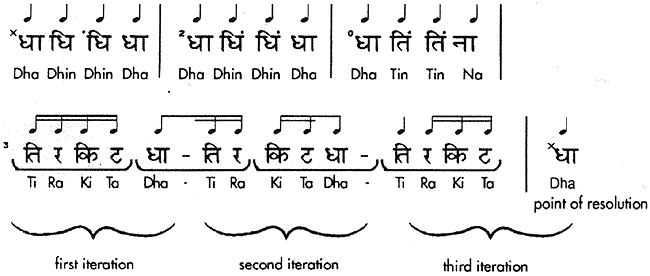
Figure 5. Tihai in Tintal
There are three philosophies for the resolution of a tihai. By all accounts the most common is to resolve upon the sam. This is so common that most works on the subject do not consider anything else. However, it must be mentioned that on a few occasions one may resolve before, or after the sam. When one resolves before the sam it is called an anagat tihai. When one resolves after the sam it is called atit tihai.
The phrases of the tihai (referred to as pala) may be linked in one of two ways. One way is to use a time interval between the three palas (phrases). This is called a dumdar tihai. The second approach has no gap between phrases. This is referred to as bedum. These two approaches are shown schematically in figure 6.
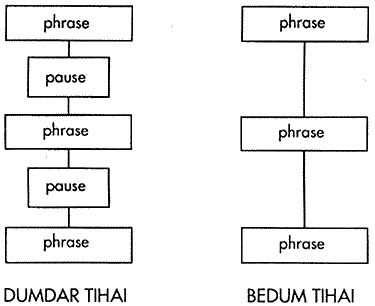
Structure of Dumdar and Bedumdar Tihai
The bedum tihai has a number of interesting characteristics. An example of a bedum tihai (Vashisht 1969:39) is shown in figure 7.

Figure 7. Bedum Tihai
We see that the phrase TiTaKaTaGaDiGeNaDhaTiDha is repeated three times without any interval between. We may generalize the character of the bedum tihai in the following formula: nL+1 = 3P where:
n = number of beats (matra) to resolve
L = layakari (i.e., single time, double time, etc.)
P = number of strokes in pala (phrase).
The application of this formula to figure 7 is interesting. We have to fill one cycle of tintal, therefore n=16; the tempo (layakari) is double-time, so L=2. The constant “1” is due to the fact that a 16 beat cycle actually resolves on the 17th beat (i.e., the first beat of the next cycle). The “3” represents the basic triadic nature of the tihai. This formula shows that it takes 11 strokes to create one pala (phrase) for a bedum tihai in tintal. There are many other values which could be used in this formula, however, contemporary performance practice usually dictates that all values be an even integer, and that common values for L are 1, 2, 3, 4, 6, 8, 12, & 16.
The dumdar tihai has surprisingly different characteristics. Dum literally means “breath”, but has the secondary meaning of a very small unit of time (Kapoor -no date). Figure 8 shows a dumdar tihai in a ten beat cycle known as jhaptal (Vashisht 1977:143).
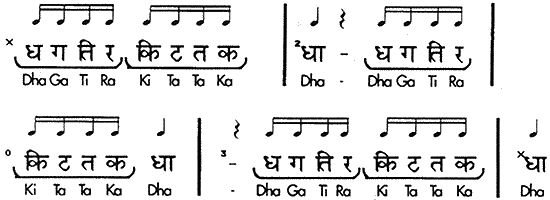
Figure 8. Dumdar Tihai
In this example the expression DhaGeTiRaKiTaTaKaDha is repeated three times with a pause in between. This form may be generalized by the formula: 3P + 2D = nL+1 where:
n = number of beats (matra) to resolve
L = layakari (i.e., single time, double time, etc.)
P = number of strokes in pala (phrase)
D = number of units in pause (same tempo as pala)
If we apply the above formula to the example in figure 8 we see the following relationships.
There are several constants in this formula. The “3” represents the basic triadic structure of the tihai, and the “2” represents the two pauses between the phrases. Again the “1” represents the resolution on the first beat of the next cycle. DhaGaTiRaKiTaTaKaDha yields a P=9. Remember that the dum (pause) must be normalized to the same layakari as the phrase (pala); therefore the last Dha is actually “Dha – – –“, and the quarter note” -” becomes “- – – -“. Therefore the value of the pause (dum) is 7. An easy way to think of it is that one is normalizing this composition so that the 16th note becomes the fundamental unit. Since this normalization required a four-to-one shift, our L=4. The entire tihai resolves in one cycle of jhaptal, therefore n=10. We get 3(9)+2(7)=(10)(4)+1. We see that this formula describe the situation quite adequately.
It should be noted that the pause or dum need not actually be a rest. It is quite common for bols to be thrown in to fill up the gap. The inclusion of bols in the dum is done for purely artistic reasons and has no theoretical significance.
There are a number of terms which are used with tihai. Occasionally the expression sankirna tihai or sampurna tihai is encountered. These terms deal with the usage of bols in the resolution of a kaida. If the entire theme of the kaida is used it is called sampurna tihai. Conversely, if only part of the theme is present, or if the theme is present in some altered form, the tihai will be called sankirna tihai.
We have seen that the tihai is the most important structure for the north Indian cadenza. Most of the cadenzas have a tihai in them at some level. Essentially, the tihai is the repetition of a phrase three times. The last stroke of the last iteration should correspond to the first beat of the following cycle. The phrases may be contiguous (bedum) or they may be separated by a space (dumdar). On occasion, terms such as atit (end after sam), anagat (end before sam), sampurna (full theme) or sankirna (fragmented theme) are encountered.
Mohara – The literal meaning of mohara is the vanguard of an army (Kapoor no date). As such it represents a flourish culminating on sam. Mohara is defined primarily by function; partially by structure; and not at all by the bol.
Functionally the mohara is a modest assertion on the part of the tabla player in classical styles. In the accompaniment of classical vocal and instrumental music the tabla usually occupies a supportive position. However, there are times when one “trades off”, and the tabla player is able to assert himself. Mohara may be used in either case. This works because the mohara is sufficiently short so as not to impinge upon the main artist, yet sufficiently lively so that the percussionist’s presence is felt. There is sometimes confusion because the mohara is functionally identical to the tukada. Therefore many compositions may be considered either mohara or tukada.
There is a clear structure to the mohara; it is of two parts. The first part is a small body of material; the second part is a tihai. The body acts as an introduction to the tihai. The mohara is generally short, usually one to three cycles in length. An example of a mohara is shown in figure 9 (Shepherd 1976:174). Since most parans have the same structure, there are many compositions which may be considered either paran or mohara.
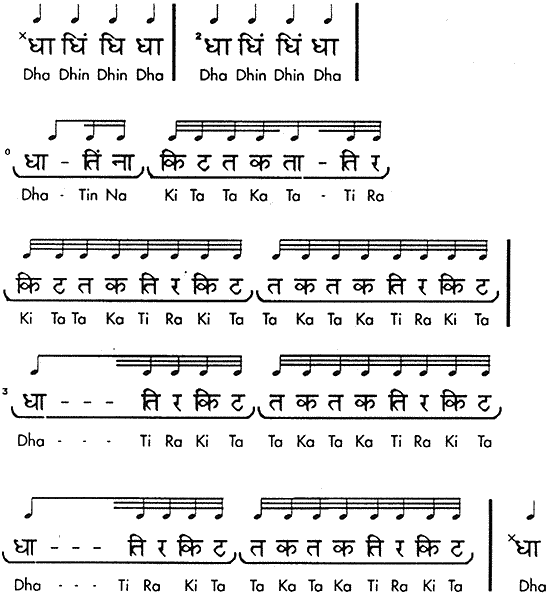
Figure 9. Mohara and Tukada
We may summarize mohara quite simply. It is a short composition, culminating in a tihai, which allows the tabla player to gently assert himself. Such an assertion is gentle enough that it may be considered as an emphasis rather than “trading off”. It has a simple structure of a small body followed with a tihai.
Chakradar – This is a special form of tihai. Chakradar may be thought of as three tihais cascaded together. Therefore the tihai is defined entirely by the structure.
The chakradar is so common that there are several subdivisions. A very basic chakradar is shown in figure 10 (Sharma 1975:164).
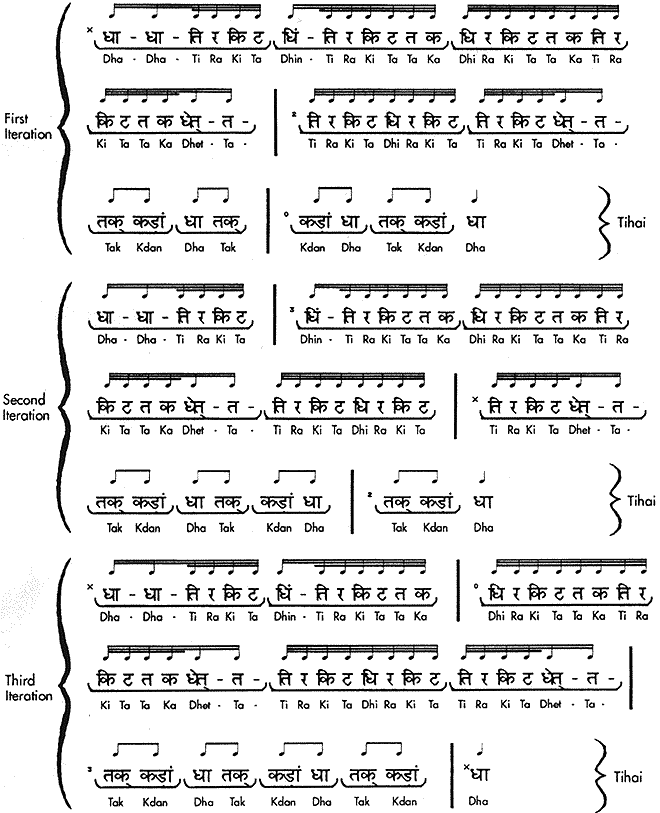
Figure 10. Chakradar Tihai
Another type is known as nohakka; the nohakka uses Dha three times in each sub-tihai for a total of nine times. One may also hear the term kamali chakradar. This literally means a “wondrous” tihai. Unfortunately there is very little agreement on exactly what a kamali chakradar is. Therefore we do not need to discuss it further.
Paran – This is a common type of cadenza. It is defined both by function and bol. Functionally, it is a heavy assertion on the part of the tabla player in the classical styles. The bol is invariably open strokes from the pakhawaj tradition. A typical example of a paran in a ten beat cycle known as jhaptal is shown in figure 11 (Mridangacharya / Shankardas 1977:26).
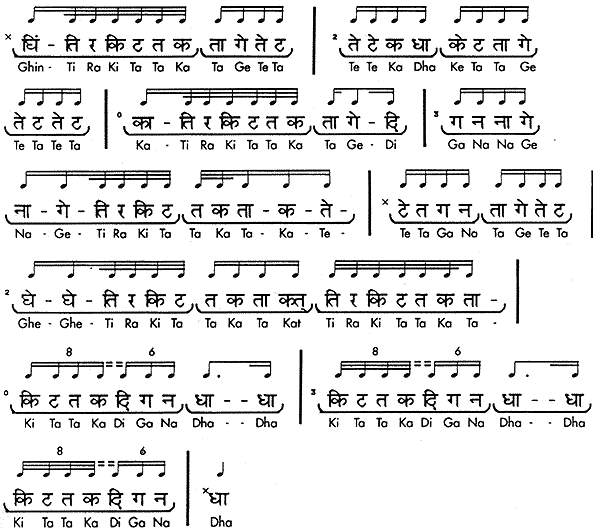
Figure 11. Paran
Although the origin of the term paran is obscure, one common belief is that it is a corruption of “parhant“. Parhant is the recitation of bols in a kathak dance recital. This could imply that the paran was a composition whose bols were so beautiful that it was suitable for a special recitation.
It is certain that the bols are the defining criterion of paran, with function acting as a strong second. The bols invariable reflect open, resonant strokes derived from the pakhawaj tradition. Bols such as TiTaKaTaGa, DiGeNa, DhuMaKiTaTaKa, or DhaGeTiTa are most common. Functionally, the paran is an aggressive display of virtuosity on the part of the tabla player. It may be used in kathak dance, tabla solos and whenever the “trading off” places control in the hands of the tabla player. This form is not found in light or folk genre and is inappropriate for general accompaniment.
Although structure is not a defining criterion for paran we may make a few observations. Usually it is structured like a mohara (i.e., a small body followed by a tihai). However, there are cases where no tihai is present.
There are various types of parans. An ekhathu paran is one which is played only with one hand. A lalkila paran, sometimes known as dohathu paran uses both hands on a single drum. A bol paran uses words of Sanskrit, Hindi or Persian in place of usual syllables. Sometimes parans are used by dancers for their characteristic greetings known as salam or namaskar. A salami paran is performed by raising of right hand to ones forehead. A namaskari paran is performed by bringing both hands together. A tar paran is one which is used with instruments such as sitar and sarod and has a structure which is consistent with these instrumental styles. A farmaishi paran is used in encores. A kamali paran is one which is considered “wondrous”. Finally there is the uthan which is typically used to open a tabla solo or dance performance.
We may therefore summarize the paran as a cadenza which is derived from the pakhawaj tradition. Both etymology and contemporary usage indicate that kathak has had a major influence in the development of this style. It is defined primarily by bol and function with structure playing a negligible part. Many different types of parans have developed over the years.
Tukada – The word tukada literally means “a piece”. Tukada is defined entirely by the bols; in particular it is defined by the use of pure tabla bols. It may be used in any style except for extremely light, or folk music. It is difficult to make any statements about the structure since this is not a defining criterion. It is usually like mohara (i.e., a small body followed with a tihai) (figure 9). However there are a few cases where the tihai is left off (Sharma 1973:31). The name tukada obviously implies something which is not too long. If the tukada is long it is sometimes called toda (H.Shrivastava 1973:84). Very closely allied to the tukada is the pirmal which is found exclusively in the dance forms.
Tipali – The tipali is a common cadenza. It is essentially a triadic composition where each of the three sections is in an increasing layakari (tempo). Figure 12 shows a tipali in tintal which was given to me by the late Ustad Shaik Dawood Khan. Tipali is traditionally classed as a gat, however, such a designation is fundamentally insupportable.

Figure 12. – Tipali
The gat is a cyclic form which is loosely analogous to the kaida, while the tipali is clearly a cadential form. I believe that such a fundamental difference requires the tipali to be classed as a separate form.
Less common than the tipali is the dupali and chopali. These forms are characterized by two sections and four sections respectively. Unfortunately these forms are rather obscure and different subtraditions have adopted different approaches. Some treat these as cyclic forms while others treat them as cadential. Some have each section in a different tempo and some do not. Therefore it is difficult to talk about these obscure forms.
Amad – The amad is a type which is used primarily in the kathak dance tradition. A characteristic amad is shown in figure 13 (Shrivastava 1973:124). Amad is defined by its characteristic bols. Structurally the amad consists of a body and a tihai. Many times the tihai is not really a tihai in the strict sense but a set of bols which gives a character of tihai.

Figure 13. Amad
| IF YOU ARE INTERESTED IN TABLA, THIS BOOK IS FOR YOU |
|---|
This is the second volume of the most complete series on the tabla. Advanced Theory of Tabla It is available around the world. Check your local Amazon for pricing. |
Summary
We have seen that the mass of compositional forms for the Indian tabla fall into two classes; cyclic and cadential. Although the cyclic material rolls along without any specific direction the cadenza moves toward a specific point of resolution. This point of resolution is almost always the sam, or the first beat of the cycle. There has been much confusion concerning the exact definitions of cadenzas. Although some confusion is a result of different subtraditions and a historically low educational level among the practitioners, the confusion can be minimized by realizing that many of these forms are defined using totally different criteria. In general these three criteria are: 1) structure, 2) function / style, and 3) bol (mnemonic/ stroke).
Structurally, most forms are a combination of a body of high density bols followed by a tihai. The tihai is the most characteristic element of the Indian cadenza; it is merely a phrase repeated three times. The mukhada and “pickup” are the simplest, being merely a body of high density bols. The mohara, tukada, paran, and amad are usually a body followed by a tihai. A chakradar is like a tihai except that each phrase is a complete tihai in itself. The tipali is three sections where each section is composed of increasing densities of strokes.
The function of the various forms is usually a question of style and level of control that the artist wishes to exert. The pickup, mukhada and simple tihai may be played any time without impinging upon the main performer. The pickup is found only in light and folk styles. Amad is found exclusively in the dance styles. Tukada, mohara, paran, tipali, and chakradar are only played when the tabla has complete control, such as tabla solos, and instrumental sections where the main instrumentalist “trades off” to the tabla player.
The bols which are used to define styles are derived from three main traditions: 1) traditional tabla bols, 2) pakhawaj bols, and 3) kathak dance bols. Amad is exclusive made of dance bols. Tukada is usually only tabla bols. Mukhada, mohara, chakradar, and tihai may use any bols. Paran uses only pakhawaj bols while tipali usually does. The folk “pickup” sometimes uses no bols at all.
Collectively they all form the north Indian cadenza. Music without a cadenza is like a speech without a breath, or a book without periods. The occasional resolution is essential to defining the body of ones artistic ideas. Without it, the music can have no soul.
| IF YOU ARE INTERESTED IN TABLA, THIS BOOK IS FOR YOU |
|---|
This is the fourth volume of the most complete series on the tabla. Focus on the Kaidas of Tabla It is available around the world. Check your local Amazon for pricing. |
Glossary
amad – A traditional dance piece.
avartan – A cycle.
bedumdar tihai – A tihai where the three phrases are played continuously without a break.
bol -Literally it means the verbal mnemonic. commonly it means the strokes.
bol paran – A paran made of poetry rather than tabla bols.
chakradar tihai – A tihai compose of three other tihais (i.e., nine occurrences of the phrase)
chopali – Four sections where each has higher bol density than the former.
devnagri – The Sanskrit alphabet.
dholak – A crude barrel shaped drum used in folk music.
dholki – A barrel shaped drum used in folk music.
dohathu – A composition that uses both hands on the same drum.
dupali – Two sections where the later has a higher bol density than the former.
dumdar tihai – A tihai where each phrase is separated with a pause or some insignificant strokes.
ekhathu – A composition which is played with only one hand.
farmaishi paran – A paran which is played for an encore
kamali paran /chakradar – An exceptionally complex paran or chakradar.
kaherava tal – An eight beat rhythm used in folk and lighter styles of music.
kaida – A very formalized type of theme and variation.
kathak – A classical dance form of northern India.
khali – The “empty” section of the cycle specified by a wave of the hand.
lalkila paran – A dohathu
layakari – The relationship between what is being played and the theoretical timebase (i.e., single time, double time, etc.)
matra – The beat.
naggada – A type of kettle drum.
namaskari paran – A paran used in dance pieces which is used with a characteristic greeting.
pakhawaj – An ancient barrel shaped drum, of complex construction formally used in classical music.
paran – A piece composed extensively of strokes from pakhawaj.
peshkar – A system of theme and variation used to open tabla solos.
pirmal – A type of tukada used in dance recitals.
prakar – Variations upon the basic accompanying patterns.
rela – A system of theme and variation based upon the rapid manipulation of small structures at a very high speed.
salam – A characteristic greeting of muslims in India.
salami paran – A dance piece characterized by the use of a salam.
sam – The first beat of the cycle.
sampurna tihai – A tihai in which the full theme of the kaida is present.
sankirna tihai – A tihai in which only a portion of the theme of a kaida is used.
sitar – A stringed instrument made popular in the West by Ravi Shankar
sarod – A stringed instrument, similar to rabab, used in classical music.
tabla – The principal drums of northern India.
tal – The system of rhythm.
tali – The clap of the hands used in Indian timekeeping.
tar paran – A paran which is used in the accompaniment of string instruments such as sitar and sarod.
theka – The basic accompanying patterns.
tukada – A small piece used in tabla solos based upon standard tabla bols.
tihai – A phrase repeated three times and ending on the first beat of the cycle.
tintal – A common 16 beat pattern used to accompany vocalist, dancers and instrumentalists.
tipali – Three phrases repeated with increasing bol density.
uthan – A type of mukhada or paran used to open a tabla solo
vibhag – A measure.
Works Cited
Apte, Vasudeo Govind
1933 The Concise Sanskrit-English Dictionary. Bombay, India. Motilal Banarsidass
Courtney, David R
1980 Introduction to Tabla. Hyderabad, India. Anand Power Press.
1992 “New Approaches to Tabla Instruction”. Percussive Notes. Vol 30 No 4: Lawton OK: Percussive arts Society.
1993 “An Introduction to Tabla”. Modern Drummer. October: Modern Drummer publications.
Kapoor, R.K.
-no date- Kamal’s Advanced Illustrated Oxford Dictionary of Hindi-English. New Delhi: Verma Book Depot
Kippen, James
1988 The Tabla of Lucknow: A Cultural Anaylysis of a Musical Tradition. Cambridge: Cambridge University Press.
Lele, V.
1978 Sathsangat. Puna, India: V. Joshi and Co.
Mridangacharya, Bhagavandas & Shankardas, Ram (Pagaldas)
1977 Mridang Tabla Prabhakar (Vol. II). Hatharas, India: Sangeet Karyalaya.
Sharma, Bhagavat Sharan
1973 Tal Prakash.Hatharas, India: Sangeet Karyalaya.(5th edition)
1975 Tabla-shiksha, Vadhya-Vadan Ank. Hatharas, India: Sangeet Karyalaya.
Shepherd, F. A.
1976 Tabla and the Benaras Gharana. Ann Arbor: University Microfilms International. (Ph.D. Dissertation)
Shrivastava, H. C.
1973 Kathak Nrtya Parichay. Alahabad, India: Sangeet Press.
Stewart, Rebacca M.
1974 The Tabla in Perspective. Ann Arbor: University Microfilms International. (Ph.D. Dissertation)
Patnakar, R. G.
1977 Tal Sopan. (Vol 2) Bulandshahar, India: Sangeet Kala Kendra.
Vashisht, Satya Narayan
1977 Tal Martand. Hathras, India: Sangeet Karyalaya.

